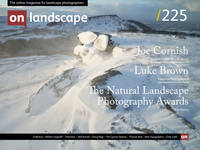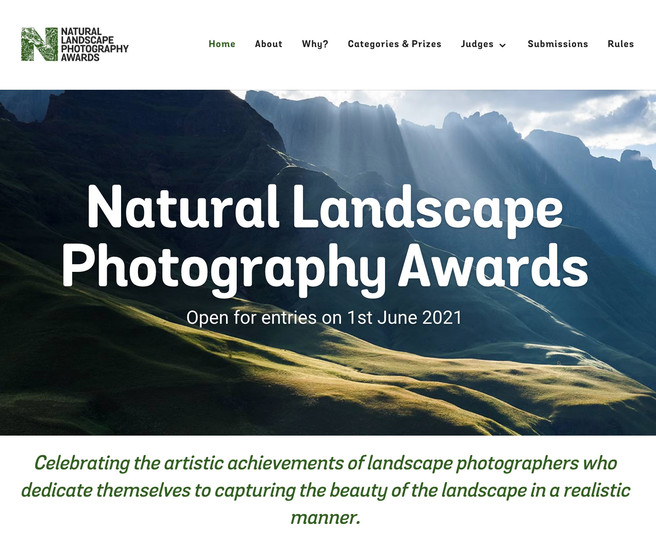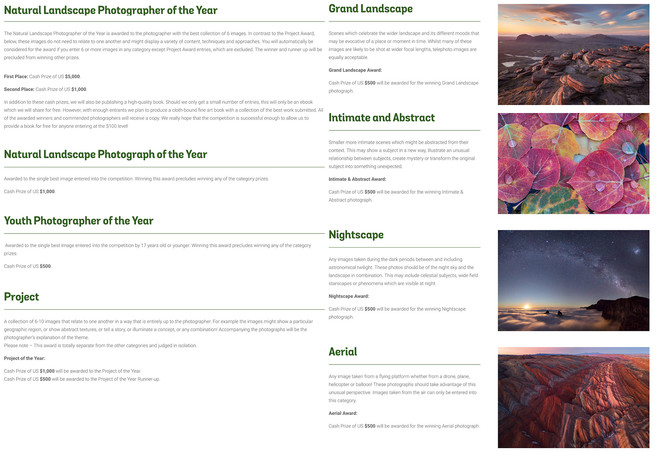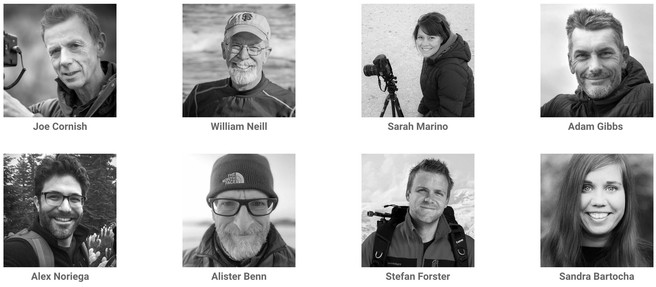Why another photography competition?

Tim Parkin
Tim Parkin is a British landscape photographer, writer, and editor best known as the co-founder of On Landscape magazine, where he explores the art and practice of photographing the natural world. His work is thoughtful and carefully crafted, often focusing on subtle details and quiet moments in the landscape rather than dramatic vistas. Alongside his photography and writing, he co-founded the Natural Landscape Photography Awards, serves as a judge for other international competitions. Through all these projects, Parkin has become a respected and influential voice in contemporary landscape photography.
If anybody has been reading On Landscape on and off over the last decade, you’ll know I’ve written about competitions a few times. I have been a little dismissive of the idea of competitions in general, even the good ones (of which there are a few). The idea of competitive art seems anathema somehow but I think we can all understand the desire to see how your work would be judged by your peers, after all this is mostly what social media does, albeit in a very distorted way!
Despite repeatedly thinking about starting a competition, mostly triggered by seeing what was winning other competitions out there, I decided it wasn’t something I wanted to get involved in. I did notice that the Wildlife Photographer of the Year had dropped their main categories for landscape photography and I must admit that this got me thinking. There were really very few if any international competitions left that were rigorous in checking raw files for ‘over editing’ on a par with what the Wildlife Photographer of the Year did.
However, one day I was chatting with Alex Nail about this and he mentioned that Matt Payne and his friend Rajesh Jyothiswaran had been thinking about competitions and so I thought we could have a chat. It turns out that we all shared pretty much the same general opinion on what a competition could be and we all had a very annoying itch that wasn’t going to be satisfied until we ‘did something’ about it. And hence the idea for the Natural Landscape Photography Awards was hatched.
But why another competition? Aren’t there enough? Well, yes - there are loads out there and if you’re amongst the many people who are happy without limits when editing your images and who are primarily interested in the end product then your needs can be well satisfied.
If, however, you’re a photographer who values the effort of capturing the decisive moment, who values the intrinsic connection between the subject matter and the final processed image, who wants to celebrate the landscape and show people what they have seen and experienced it is difficult to find a level playing field for landscape photography.
I’d like to include what we’ve written on our “Why” page here...\
Why?
One of photography’s unique features is its ability to clearly represent the visual experience of the world. The deep connection between the photograph and the scene it conveys has shown the world the beauty of nature, helped convince politicians to create our national parks, shown people their effect on natural habitats and broadened the horizons of nearly every human on earth. There are few who have not marvelled at a National Geographic feature about some far-flung habitat or browsed a Sierra Club or National Trust book and had revealed to them their own treasured landscapes.
Historically, there have also been many celebrated artists who have used the camera to create works that diverge from representation in ways that no longer portray the landscape but interpret it. The Pictorialists used all the tools they had available to show just what photography was capable of as an art form.
But we now live in a world where there are blurred lines between these two aspects of photographic art. Our social media feeds show both approaches side by side with little to differentiate them. This current status quo is somewhat inevitable and understandable. However, when competitions do not make any distinction between the two, we are faced with a conundrum; Photographers who try to work within the boundaries of the landscape they actually experienced find it difficult to compete with photographs that depart from these constraints. The competitions we see online sometimes reward the technical skills of post-processing, compositing and graphic design over the challenges of working within the limits of the real world. How rarely can a portrayal of a real scene compete with the deluge of extraordinary juxtapositions of perfected moments?
The founders of this competition want to create a place where the field skills of the photographer are celebrated, where the post-processing and interpretation of images respect the inherent truth of the scene experienced, and photography aware viewers would not feel deceived by the end result if they were to see that original scene themselves.
How are we going to achieve this?
We realise that there is nothing gained by banning all aspects of image processing, which is after all an integral part of our art. We will be allowing all techniques that respect the visual integrity of the image and subject. As long as that proposed imaginary viewer, who understands how photography works, would not feel deceived if they were able to experience the moment of capture themselves, then the photographer has connected them with the landscape.
To ensure that this is the case, any photographs that get past the first stages of the competition will need to provide RAW files in support of each entry. We will check each image to make sure it does not break any of the post-processing rules we have put forward.
The judges will make the final subjective decisions on whether the post-processing is too much or just right. Undoubtedly there will be grey areas and we look forward to some robust debate!
We have also given considerable thought to the process of judging itself, which can be prone to various problems. It is inevitable that when zipping through so many images, a ‘WOW!’ photo with vibrant colours or a photo from an unusual angle will stand out. This is why so many photographs from iconic locations in extreme conditions, unusual aerial perspectives, astro images, and inventive composites do disproportionately well in competitions. We hope to eliminate these judging problems by doing the following:
-
- Creating separate categories for astrophotography and aerial images, subjects which often catch judges eyes and possibly distract from other genres.
- Creating a separate category for intimate landscapes - a genre that is often overlooked when seen against a stream of epic views.
- Preparing and briefing judges on what to expect and developing a process to help selection.
- Having a scoring system that guides the judges into assessing composition, light and subject and not just the instant visual impact of an image.
- Letting judges promote their favourite selections in an open discussion in the final rounds.
Prominently showing the judges individual choices in the results as well as the collective final choices
We believe that all these steps will help give each image a strong chance, whether it be a spectacular aurora over a glacier or a softly lit willow tree.
We’ll be developing and expanding the rules over the coming weeks so feel free to let us know if you have any ideas.
Environmental Consideration
It’s difficult to separate the consideration of landscape photography from consideration for the land itself. If we say we engage in our craft out of love for the land, we really should consider its future in these changing times. As mentioned above, photographers have played a major part in many environmental movements, from the creation of National Parks like Ansel Adams’ work on the "Sierra Nevada: The John Muir Trail" book which helped save King’s Canyon to the campaigns against industrial developments like Eliott Porter’s work in Glen Canyon or Peter Dombrovskis’ beautiful work that helped save the Gordon River from the Franklin Dam development. We have to ask ourselves whether these images would have been that successful if the opposition could have said “that’s just photoshopped to look beautiful”. For many areas of relative wilderness, we are the eyewitnesses who are bringing back the message “look what you would see and experience if you came to look!”.
Sadly, landscape photography also has the potential to be part of the problem. With little consideration for where we travel and stand, ‘honeypot’ locations can be permanently damaged. Excessive international travel can no longer be seen as impact-free either and we all have to consider how we find a balance between the two extremes of never leaving the house by powered transport and multiple international expeditions every year. There is no perfect answer and each person needs to find their own solution.
We feel our competition should address this in some way and we’d like to have some submissions of work that reflects these personal solutions. This might be from a project taken within walking distance from your home, an important visual story that you found whilst travelling around the country where you live or by using your international travel to show a new way of seeing the world that could inspire people to protect it.
In that light, we are planning an environmental award for both the single image section and the project section. Just as there are is no right answer for how each person should adapt themselves to changing environmental conditions, we don’t profess to know what an inspiring environmental winner would be so we’re looking for you to enter and let us know.
More Information Soon!
We're only at the start of our journey creating this competition and we're still fine-tuning a few things so please let us know if you have any ideas. Once things have settled down, I'll write another article looking at some of the categories, fees, prizes and processing rules which should give you some idea of what and how you can enter if you wish to. To see where our ideas are at the moment, please visit https://naturallandscapeawards.com and have a look around.





